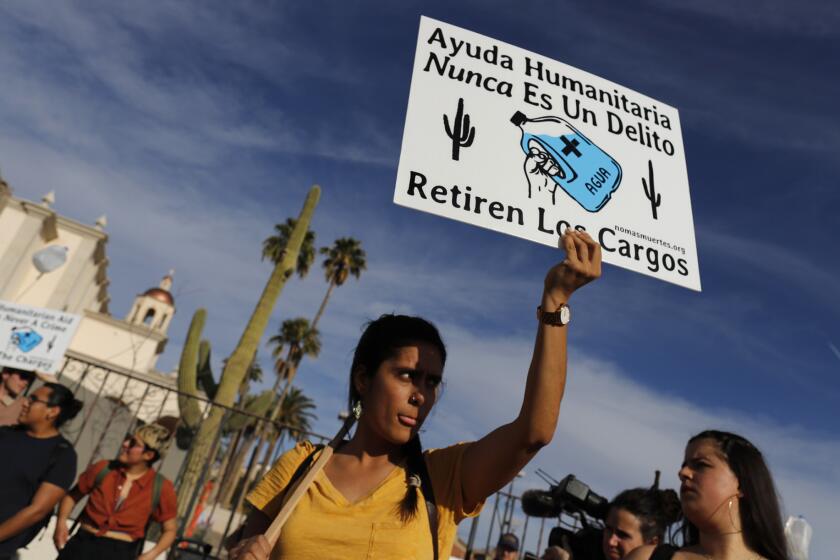Deaths along Arizona border on track for record after state’s hottest summer

- Share via
DOUGLAS, Ariz. — Heat exposure killed 19-year-old Cesar de la Cruz on an Arizona trail in July during his trek up from southern Mexico. The body of Juan Lopez Valencia, another young Mexican man, was discovered Aug. 3 along a dry wash on Native American land.
After the hottest, driest summer in Arizona’s history, the number of bodies recovered of people who crossed from Mexico into the state’s deserts, valleys and mountains is closing in on a 10-year record. It’s a reminder that the most remote paths to enter the U.S. can be the deadliest.
Border enforcement efforts in neighboring states have helped drive people into Arizona’s difficult terrain, and some officials and activists believe stepped-up construction of President Trump’s border wall this year, largely in Arizona, also could be pushing migrants into dangerous areas without easy access to food and water.
De la Cruz and Lopez Valencia were among 214 confirmed or suspected migrants whose deaths at the Arizona border were documented from January to November by the nonprofit Humane Borders and the Pima County Medical Examiner’s Office, which together map recoveries of human remains.
“There’s no doubt in my mind that the high temperatures have had a lot to do with it,” said Mike Kreyche, Humane Borders’ mapping coordinator.
The highest annual number that the project has documented was 224 in 2010. It’s possible that 2020 will exceed that once December is factored in.
Contractors using dynamite to pulverize mountaintops in the remote and rugged southeast corner of Arizona are forever reshaping the landscape.
The U.S. Border Patrol keeps its own statistics, counting the remains of suspected migrants that it learns about in the course of its duties, according to its parent agency, Customs and Border Protection. CBP said that if another agency recovers remains and doesn’t notify the Border Patrol, it won’t be included in its tally.
For the first nine months of 2020, the Border Patrol listed 43 deaths in the Yuma and Tucson sectors that make up the Arizona border area. The mapping project tracked 181 deaths over the same period.
During the 2019 calendar year, the federal government listed 70 deaths in Arizona, while the mapping project counted 144.
Federal statistics show that search-and-rescue operations near Arizona’s border inexplicably dipped to 213 during a record-hot July and August, down from 232 in July and August 2019. But early fall figures indicate that rescues across the Southwest were trending up.
A government auditor did not employ medical professionals when his office cleared U.S. border agents of wrongdoing in the deaths of two Guatemalan children, ages 7 and 8.
The National Weather Service in Phoenix says the average high temperature was nearly 110 degrees in July and nearly 111 in August, helping make it the hottest summer in history. Phoenix’s highs tend to be roughly the same as those in Arizona’s Sonoran Desert just north of the boundary with Mexico, forecasters say.
The weather service said July and August also were the state’s driest summer months on record.
Some officials and activists working near the border believe that wall construction could be sending migrants into riskier places. The Trump administration expects some 450 miles of border wall to be completed by year’s end, much of it in Arizona.
“The wall has sent a lot of people to rough terrain in our area,” said Santa Cruz County Sheriff Tony Estrada, whose jurisdiction includes Nogales.
News Alerts
Get breaking news, investigations, analysis and more signature journalism from the Los Angeles Times in your inbox.
You may occasionally receive promotional content from the Los Angeles Times.
The remains of more than 3,000 migrants have been found near the Arizona border in the two decades since heightened enforcement in San Diego and El Paso began driving people into Arizona’s deserts and mountains.
Authorities have been able to identify about two-thirds. Most came from Mexico and Guatemala, Honduras and El Salvador.
“It is important to remember that these are human beings, not just numbers,” said Tony Banegas, CEO of the Tucson-based Colibri Center for Human Rights, which works with the medical examiner’s office to help identify the bodies. “The only thing we can be sure of is there are a lot more people who died out there that we don’t even know about.”
In southern Arizona, No More Deaths and similar humanitarian groups leave water jugs and other provisions in remote places. The group gained national attention when one of its members was tried and acquitted last year of harboring migrants.
U.S. Customs and Border Protection calls its actions against No More Deaths law enforcement. The humanitarian group calls it a violation of international Red Cross standards.
Estrada, the Santa Cruz County sheriff, said he’s worried that officials may see higher numbers of deaths next year if big groups of migrants surge to the border in hope that President-elect Joe Biden’s administration will be more welcoming.
“These people will keep coming because most of them have nothing back home,” Estrada said.
More to Read
Sign up for Essential California
The most important California stories and recommendations in your inbox every morning.
You may occasionally receive promotional content from the Los Angeles Times.
















